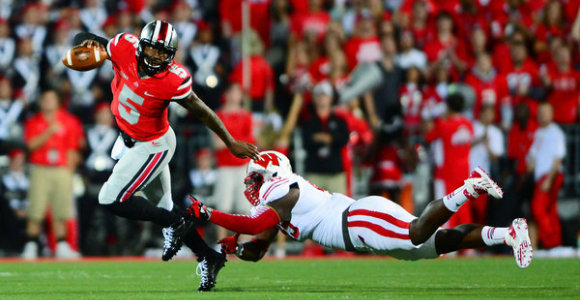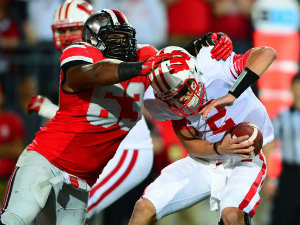
The game – and the numbers – were ugly. But the Urban era trucked on to 17-0 regardless, setting up next week's matchup as a College Gameday-worthy face-off for the Big Ten.
I have three overriding questions from last night: 1. Did the offense just seem a little rusty or do the numbers support that too? 2. How was the defense lockdown against the run but allow career highs for the opposing passing game? 3. Is this team statistically worthy of its ranking and can it contend with the other top-5 teams?
Just Shaking Off the Rust?
In their first test against a real, live, breathing defense, the Buckeye offense sputtered at times. If the offense could execute consistently, it is clear that the Buckeyes are talented enough to score on anyone in the country.
The Miller-led offense scored on 5/12 drives, picking up points on every other drive until the second half before closing out the game with three ugly attempts to bleed the clock.
| Yards/Play | Yards/Point | Points/Play | |
|---|---|---|---|
| Offense vs. Wisconsin | 5.7 | 12.6 | .46 |
Though the second half probably left a bad taste in your mouth, the offense performed almost as well as it did against Cal, especially when looking at points per play (PPP). The Buckeyes had .59 PPP in Berkeley against a much less efficient defense. Yards per play was significantly lower (~1.2 YPP) against Wisconsin, suggesting that the Buckeyes were fairly efficient in getting points out of drives due to quality field position. In fact, eight of the Buckeyes' drives started on the Buckeyes' 30 or better.
So was the Buckeye offense "exposed," Braxton "rusty," or in need of a little Kenny G/Hall time? I think it's fair to answer no, probably not, and yes. Jordan Hall and Kenny G were extremely limited, which is surprising given their effectiveness during the past three games. However, Braxton's throwing mechanics, escapability, and open-field running all suggest that he didn't lose much from his MCL-imposed hiatus.
- The Buckeyes ended with six explosive plays (three on the ground and through the air) compared to Wisconsin's four.
- Arizona State (the other good team the Badgers have faced) had 468 yards of total offense on 93 plays. That's actually just .34 PPP and 5.03 YPP, indicating that the Buckeyes had a better day against the Badger defense. The Sun Devils just put up 62 points on USC.
- Hyde had just a 41% Running Back Success Rate, though this was artificially low due to the play calling – Hyde's number was called more than usual on second- and third-and-long. However, Hyde's effectiveness (and the offense's in general) was significantly limited in the second half).
- The Buckeyes are second in the country (along with Air Force, Army, and Oregon) in explosive run plays this season.
- Cam Johnston deserves a shoutout for his amazing fourth quarter 55-yard punt. All six of his punts landed inside the 20 against Wisconsin and Abbrederis only managed three return yards.
How to Stop the Run
 Bennett and the defensive line deserve praise
Bennett and the defensive line deserve praise I have little doubt that the Badgers will end the year as one of the nation's best rushing offenses (assuming Melvin Gordon returns to full strength), but the Buckeyes put on a clinic on how to stop power running offenses.
One measure of run defense is looking at the opposing running backs' RBSR, which controls for games in which the yards per carry is high due to one or two outlier explosive run plays. Melvin Gordon managed one explosive run – a 16 yard scamper – but the nation's leading rusher before the game was largely kept in check:
| RBSR | Explosive Plays | |
|---|---|---|
| Melvin Gordon | 47% | 1-16 |
| James White | 38% | 1-17 |
You have to be ecstatic with numbers like that, especially considering the opponent.
The pass defense on the other hand? Not so much. We knew after the Cal game (as well as all of last season) that the Buckeyes struggled with short passes, screens, and other dink-and-dunk style offenses (like Northwestern's), but Stave and Abbrederis both set career highs against the Buckeyes.
Stave's 8.7 yards per pass was even better than their output against Purdue (7.5 YPP). This "elite receiver setting career records against Ohio State" meme needs to end soon, with Cal's Treggs and Harper both getting the better of Roby as well.
| Tackles | TFL | Sack | PBU | INT | FF | |
|---|---|---|---|---|---|---|
| Shazier | 9 | 2.5 | 1 | |||
| Roby | 8 | 1 | 3 | 1 | ||
| Perry | 7 | |||||
| C. GRant | 7 | 1 | 1 | |||
| Bennett | 4 | 1 | 1 | 1 | ||
| D. Grant | 3 | 1 | ||||
| Spence | 1 | .5 |
We'll examine the tape in the Charting Project to see exactly where the problem lies, but opponents throw early and often against Ohio State. The pass defense is 54th in the country and opponents are averaging 35 throws per game, indicating that opposing offensive coordinators have identified the Buckeyes obvious weakness. Losing Christian Bryant – a vocal leader and underrated defender – for the season definitely won't help.
However, I don't mean to sound doom and gloom on the defense. There is a lot of young talent that will get the chance to develop throughout this season, while Doran Grant, Bennett, and Shazier all had fantastic days against Wisconsin. The Buckeyes won the turnover battle while forcing two additional fumbles that weren't recovered by the defense.
Yesterday proved that Columbus is certainly the court of the B1G King; now it's on to bigger and better things.

